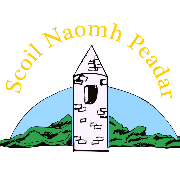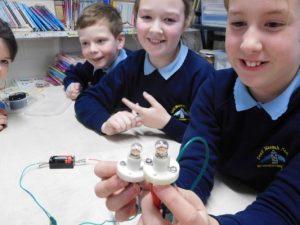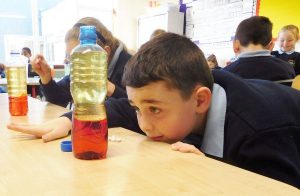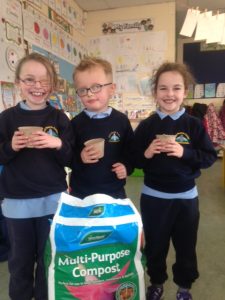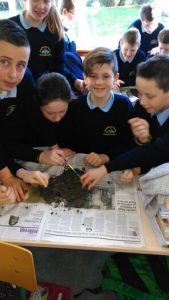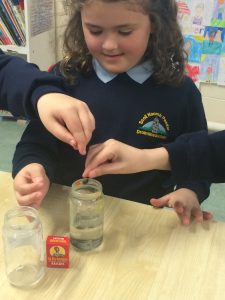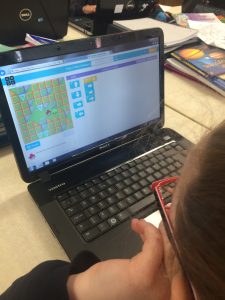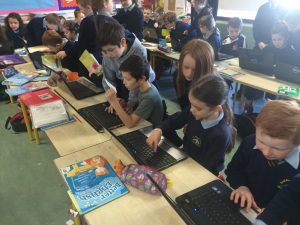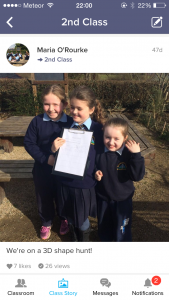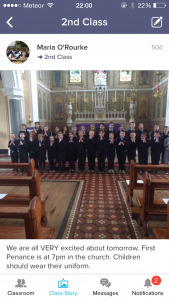Welcome to the Discover Science Award section of our website. On this page you will find a sample of the Science, Technology, Engineering and Maths activities that have happened in the school year 2015-2016.
Step 1 – Science
Hands on experiments
1. Living Things (Plants and Animals): Hatching Chicks (3rd Class)
As part of our SESE Ms Lambert decided that we would be very ambitious and try and hatch our own chicks!! To read our account, please visit the page on 3rd Class by clicking HERE.
Click this link for videos of the chicks hatching.
Click this link for pictures of the chicks and our class.
Click here for samples of the children’s work and to see our display!
Senior Infants also visited the chicks, have a look!
2. Energy and Forces (Electricity): Circuits (4th Class)
Our class experimented with electricity using wires, lightbulbs and batteries. In groups we had to figure out how to turn the lightbulbs on using the circuits and batteries. We had lots of fun and learned a lot about how electricity works. We now know the difference between simple circuits, series circuits and parallel circuits.
Click this link to see photographs from our experiment.
Click here for samples of work.
3. Materials (Materials and Change): Lava Lamps (Junior Infants, 2nd Class and 3rd Class)
We created our very own lava lamps using materials that are easily found around the house: oil, water, food dye, Alka-seltzer tablets and plastic bottles. First, we poured water so that it filled half the bottle. Next, we poured vegetable oil into the bottles. We noticed that the oil and water did not mix. We then put three or four drops of food colouring into the mixture. The food colouring went straight down to the water. When we put the Alka-Seltzer tablets into the mixture we noticed that things started to change. Once the Alka-Seltzer tablets reached the water they created a reaction and made carbon dioxide. Before we knew it we had our very own lava lamps as the combination of all the ingredients created a fantastic reaction!
Click here to see a video of our lava lamps in action!
Click this link for photographs from our experiment.
After seeing the 3rd Class lava lamp, 2nd class decided to recreate the experiment. Listen closely to the video and you will hear Aodhán explaining what is happening. Click here to listen in.
Second Class also showcased the experiment to Junior Infants. You can find our flipogram HERE.
4. Environmental Awareness and Care: Planting Seeds (Senior Infants)
We got our plant pots ready. We filled the pots with compost. We used our finger to make a hole in each pot. We placed one seed in the pot and covered loosely with soil. We watered the pots and placed them in a sunny spot. They’re already starting to sprout thanks to all our hard work!
Click this link for pictures of us planting our seeds and our reports.
6. Living Things: Investigating Soil (5th Class)
During the year we examined soil and what exactly it is made of. We learned loads about how it is formed over thousands of years and what we can expect to find in each of the different layers of soil. We knew from previous experiments what plants need from soil in order to grow but we asked ourselves “Do all soils have the same nutritional value as others?”
Click here for the explanation about our experiment.
Click here to see a sample of our experiment write up.
Click here to see photographs from our experiment.
6. Materials (Properties and Characteristics of Materials): Rocks (4th Class)
4th Class examined the properties of lots of different rocks. We used magnifying glasses to examine the rocks up close and noted, compared and contrasted the different characteristics. We weighed the rocks and checked, using magnets, to see if they were magnetic. We also checked to see how the different rocks reacted to water and other liquids. Overall, we saw lots of differences and some similarities between all the rocks.
Click this link for pictures of our experiments.
Click here for samples of work.
7. Energy and Forces (Forces): Dancing Raisins (2nd Class)
Our experiment was short and very sweet! All we needed was a jar of water, a jar of clear fizzy liquid (we chose 7up!) and some raisins. Our first step was to place the raisins in the jar of water. We predicted that nothing would happen and we were right. The next part of our experiment was the put the raisins into the fizzy drink. Some of us predicted that the raisins would sink to the bottom and some of us predicted that the raisins would float at the top. Only one person in our class correctly predicted the outcome! Once the raisins were in the water they sunk to the bottom of the jar but then the bubbles from the fizzy drink gathered around them and, before we knew it, the raisins floated to the top. The bubbles burst at the top of the jar and the raisins sunk again. This repeated until the fizz was gone and the raisins stayed at the bottom of the jar. We thought it was pretty cool and some of us showed our families at home.
Click here to see photographs from the experiment.
Click here to see a video from our experiment.
In order to qualify for the plaque: Science Speaker
First Class invited Eryn’s mum Majella and her colleague Michael from MSD in Swords to tell us all about their work in the laboratories and to let us have some hands on experience by carrying out some simple experiments.
Firstly, we listened to information about their work in MSD making medicine and vaccines to help us when we are sick. It was very interesting to see the scientists at work. Then some of us got to put on our lab coats and safety glasses to help carry out the experiments.
Our first experiment showed us the importance of proper hand-washing to prevent the spread of germs. Secondly, we carried out an experiment to show exactly how quicksand works and how to escape if we were ever to get trapped in quicksand. Our final experiment showed the difference in some everyday liquids. By adding cabbage water to liquids and watching for a change in colour we were able to figure out whether they were acidic or base liquids. It was fantastic. We really enjoyed having Majella and Michael to visit and we thank them for the opportunity.
Click this link to see photographs from Majella and Michael’s visit to 1st Class.
Step 2 – Technology
1. Participation in Hour of Code (First Class – Sixth Class)
Scratch (Second Class)
First Class up to Sixth Class have been using the Hour of Code website to practice computer coding this year. Each of these classes had a special log in page on their class page on our website. Second Class have been doing weekly coding with Ms. O’Rourke. We have children in our class who have progressed through four or five of the courses available on the Hour of Code website and they have written hundreds of lines of code as a result. One of our favourite games to code was the flappy bird game. We also liked the Angry Birds mazes throughout Course 1. It was a great introduction to coding and we liked that we could use it at home as well. We got so good at it that we got to teach First Class how to code!
Click this link to see pictures from our Hour of Code sessions.
Click this link to see a video from one of our Hour of Code sessions!
Second Class have also embarked on computer coding using Scratch. We have individual logins and work on our own individual projects and group activities. We have found it more difficult than Hour of Code but we enjoy using Sprites to make our own stories and games.
Click this link to see an example of Scratch in our classroom.
2. Peer Laptop tutoring (1st/2nd Class) and (2nd/6th Class)
We are very lucky in our school to have two laptop trolleys with 16 laptops in each trolley. This year we have had peer tutoring sessions between 1st and 2nd class. During the sessions 2nd Class have shown 1st class how to turn the laptops on and off safely and correctly. We work together in pairs and play games, write code and type in Microsoft Word. Sixth Class also visit Second Class for peer tutoring sessions where Sixth Class children help us to save files to the server, type stories and poems into Word and add advanced features such as clip art and page borders. Second Class then act as the experts by showing Sixth Class the coding we do in our weekly coding sessions.
Click this link to see First and Second Class working on the laptops together in December.
Click this link to see them in March 2016.
3. Children developing videos (2nd, 3rd, 4th, 6th)
Designing videos is used across a range of classes in our school. We have included an example from 2nd (Designing and Making Boats), 3rd (The Water Cycle), 4th (Fair Trade) and 6th (Poverty, Global Warming Video). You will also find another video in the STEM showcase section below.
4. Evidence of using Powerpoints (6th Class)
Sixth Class use powerpoints for a variety of reasons. A sample powerpoint about Fair Trade is included HERE.
Click this link to see other powerpoints from Sixth Class.

5. Safer Internet Day (5th Class)
Fifth Class participated in Safer Internet Day this year in February by performing the Anti-Bullying Rap “I Like It” at our school assembly. It highlighted the dangers that social media sites and apps can pose but also gave advice on how to make the internet a safer place, especially for children.
Step 3 – Engineering
1. Design and Make: Boats (2nd Class)
Splish splash! There was great excitement when the children in 2nd Class worked in groups to design and make boats in class over the space of a week. We examined all the boats and compared and contrasted them before, during and after their maiden voyages. Some boats worked better than others and we discussed the reasons why some boats stayed floating, while others sank. We also experimented with moving our boats from one side of the water tray to the other. Some boats moved quite easily and quickly, while others needed a little….help! It was one of the best things we have done in class this year (so far at least!). What made it even more super was that we used the app Flipogram to make a video of our photographs and video clips. Our teacher was very impressed that some children designed and made their own boats at home and brought them in to see how they did on the water tray. They were very high tech and had lights and other super additions added.
Click here to see the video!
Click here to see our photographs!
2. Visit by an Engineer (2nd Class)
In April we were very lucky to be visited by Tom Donaghy, who is an engineer with GPS2Find. Tom visited 2nd Class and explained what an engineer is and what they do. Tom shared some secrets of the industry with us and we learned that it is very important to lay out and store tools correctly. If you’re dismantling something it helps to lay parts out in order on a tray. We also learned about different types of engineers and learned what a biomedic engineer can do. We really found the tips Tom explained very interesting and there were a few of us who put them into practice before the end of the day! Finn was busily working on improving a pen and Matthew was hatching his next engineering project.
We learned about a famous Irish engineer called Alexander Mitchell. Alexandar went blind at the tender age of 22 but didn’t allow that to deter him. He set up a brick laying company and actually invented the screw-pile lighthouse. There is actually one of these in Dundalk Bay! Tom gave us a link to research a little more about Alexander (HERE) and some of the class used their free laptop choice time to research him a little more in depth. We are planning on writing projects about him next month.
Towards the end of Tom’s visit we got to examine an example of a Machine to Machine (M2M) product. It was a GPS tracker that can be used by people who have dementia. If they lose their way they can signal for help and a text message is sent to their designated person, who can track their exact location. You can also set up a boundary area and if the person with the tracker leaves that area, the designated person receives a text message. It was cool to track the kids from our class who got to go outside with the tracker on Tom’s computer and our IWB. You can see some examples of the tracker photographs HERE.
The most important message that Tom left us with was that good engineers never stop learning. They are constantly teaching themselves new skills. Tom told us he is teaching himself how to weld, which we were even more impressed by when our teacher showed us a video of what that means. Engineers are “greedy for knowledge”.
Click here to see photographs from the class visit.
Step 4 – Maths
1. Developing Maths Trails
As part of the School Self Evaluation process this year, each class teacher has created a series of Maths Trails around the school.
Click for the 4th Class Maths Trail around St. Peter’s N.S.
Click here for the 2nd Class Shape Hunt on our school grounds.
Click here for the 6th Class Maths Trail.
2. Questionnaire analysis (6th Class)
The theme for the 8th green flag was global citizenship. As part of the whole school work towards earning this flag Sixth Class designed and distributed questionnaires to every family in the school about their energy consumption. They then calculated and analysed the results. It was a LOT of work but it was extremely worthwhile and we got a lot of useful information that will hopefully help families in our school to make better energy choices. The results were then sent to the parents. Click here for the questionnaire. Click here to see the RESULTS of the questionnaire. It is hoped that this new information can help families in our community make better choices with their energy consumption.
3. Maths Tallies (2nd Class)
Second Class learned all about tallies. We learned how to read them and write them. They are a really quick way to count something, especially if there is a large number involved. We had a Maths trail around the school and needed to answer using tallies.
Click here to see samples of our tallies.
4. Bar Charts (4th Class)
Fourth class surveyed eachother on their “favourites” and created bar charts to represent the results. Some examples were our favourite football teams, favourite seasons and favourite subjects.
Click here to see our bar charts from September.
Step 5 – STEM Showcase
As part of our preparation for our new Green Flag – Global Citizenship Energy – 4th class decided that they would examine Renewable Energy. We use energy to provide electricity in homes schools and factories, to provide heat and to run our cars, tractors, lorries, ships and planes. To create this energy we burn amount of fossil fuels such as coal, oil, gas and peat. In doing so we cause a lot of pollution through carbon dioxide and, before long, if we continue as we are, the world is going to use up all these fossil fuels.
We have to find new ways to supply our energy and to do this we must look at sources that are renewable, that will not run out. Renewable energy can be collected from resources such as sunlight, wind, rain, tides, waves, and geothermal heat. We must look at cutting down our dependence on fossil fuels and develop and improve use of our renewable resources. To spread this message we decided that we would perform a drama for the whole school. Farmer Brown Goes Green tells the story of Farmer Brown who turns down Mrs Green’s, from SEI, offer of a wind turbine. However when the fish in his pond die, his crops wither and his sheep fall sick because of pollution he changes his mind. He installs a wind turbine and with the money he receives for generating electricity he is able to restock his fish pond, buy new crops and pay for a vet to make his sheep better. And this energy is renewable and doesn’t cause pollution. We also sang our renewable energy song which has a very important message. It was a fantastic showcase of everything the children learned about renewable energy.
You can see the entire play by clicking this link: 4th Class Renewable Energy Video
You can see photographs from the play by clicking this link: 4th Class Renewable Energy Photographs
You can see samples of the children’s projects by clicking this link: 4th Class projects
Sixth Class visited each class and presented their project work about Fair Trade (linked above) which included a question/answer session, powerpoint presentation and whole school play about Fair Trade.
Second Class visited Junior Infants to showcase two of their experiments: dancing raisins and lava lamps. They showed the Junior Infants the steps involved and talked through their findings. Both classes gained a lot from their sessions. Click HERE to see what happened.
Fifth Class presented their Internet Safety rap to the entire school during an assembly.
Second Class have showcased their computer coding skills by working with First Class and Sixth Class. The next step is to have an open hour for parents to visit during a coding session.
Second Class also use Class Dojo as a mini-blog that only parents from our class have access to. We love posting updates about what we have done in class, prizes children have won or important information that our mums and dads need to know. You can see some a sample of some of the screenshots above.
There was great excitement throughout the school when 3rd Class hatched their chicks. Every class got to visit and hold the chicks and hear information from the children in Third Class. The class also kept the wider community informed through the school website and Twitter feed.
Senior Infants visited the chicks, have a look!
Second Class also showcased their lava lamp experiment to Junior Infants. You can find our flipogram HERE. They really enjoyed explaining the different steps involved in the experiment and walking Junior Infants through the entire thing. Second Class also did a great job of helping Junior Infants to make predictions about what they thought would happen next.
